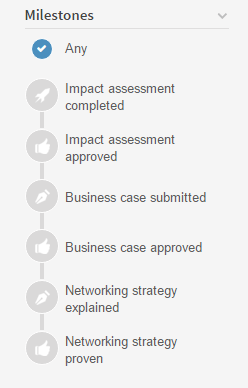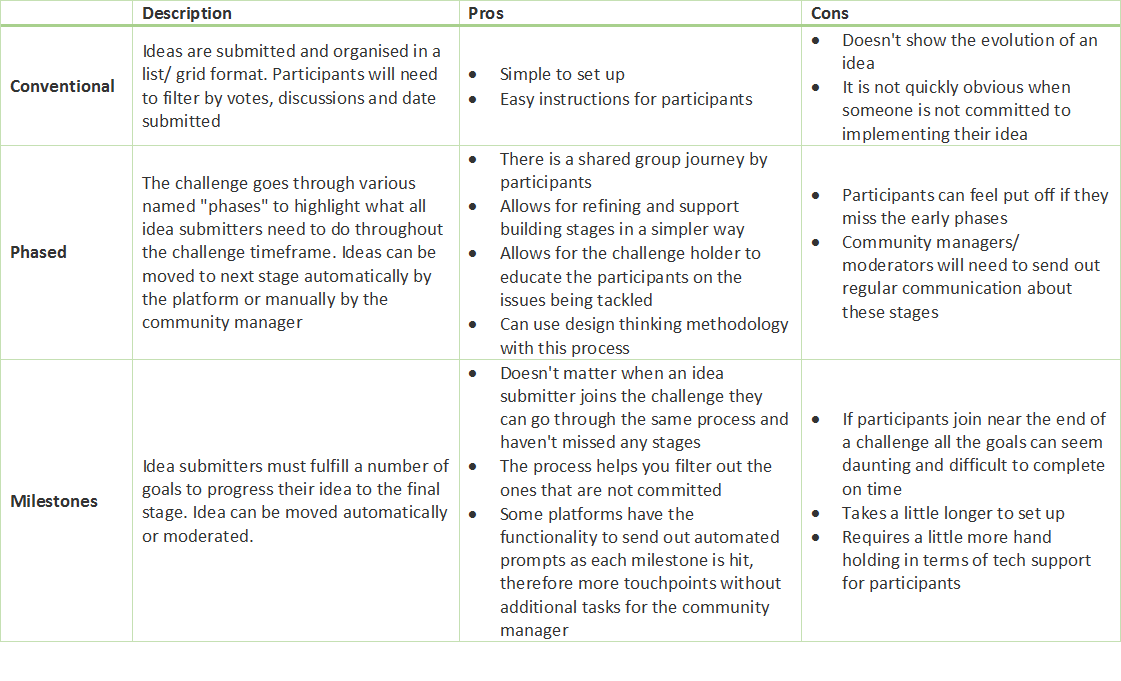Conventional vs. Phases vs. Milestone challenges
The format of a challenge will determine how ideas develop. One option is to have an open challenge with one phase: for example, four weeks of submitting ideas, posting comments and voting, which could be done through a Facebook group or an idea-management platform. We'll refer to this as the “conventional” method.
Another way to set up a challenge is by adding various “milestones”. Some platforms will allow you to set a number of voting and comment goals for each idea, in order to progress it. This option can act as a great motivator for teams to work on their original idea and develop it further. Most importantly, it can help to identify those who are committed to their idea and keen to follow through with all the milestones, and those who are merely “brainstorming”.
Some milestones for idea-submitters (and some guideline response timings) include:
submitting ideas and gathering comments (two weeks for existing communities; three weeks for new communities);
completing an impact-projection survey (5–7 days);
participating in an idea-development call (5–7 days);
gaining "X" no of votes on your idea (5–7 days);
answering an additional question (3–5 days);
and submitting a stakeholder interview (two weeks).
You may be able to configure some of these milestones on your chosen platform, but participants will need reminders. Here’s an example blog you can add to your platform to share information about this.

Milestones work well within closed communities and for participants who are already familiar with crowdsourcing challenges; they are not ideal for new communities that need to grow. This is because, in newer communities, invitations to grow the community tend to be sent out during the voting phase and new members often only finish registering after voting has closed. Since voting goals often feature as typical crowdsourcing milestones, this model is not as effective for new groups as the conventional, one-phase method.
Even though milestone challenges come with a pre-decided final deadline, participants are able to move at their own speed through the milestones – as long as they meet the ultimate deadline. Given this, there tends to be an urgency to keep moving.
A phased challenge is different from a milestone challenge in that all participants follow the same timeline and journey, entering phases en masse, rather than at their own pace. While milestone challenges require participants to tick off all the goals in their own time by a final deadline, phased challenges require participants to move through the phases as one (phases are live for a certain number of days or weeks).

During a phased challenge, it’s important to get the bulk of your participants interested at the beginning of the challenge – this is because the community takes the same actions at the same time. The problem is that late-comers feel put off if they've missed out on some of the phases, and feel reluctant to submit an idea because they believe it’s “too late”.
We've highlighted the advantages and disadvantages of each method below:

Further reading
Nesta has put together a great resource on running challenge prizes, which includes some useful information about conventional vs milestone challenges on page 20.
Touch point reminders
It’s important to keep track of when you need to communicate with your community, team and partners. Click here for a quick guide to key touch-points, in addition to suggestions already made. For further advice, see more on how to communicate with your participants.
Home page set up
How you set up the landing page for your challenge will influence how members engage with the challenge. If you have quite a few ideas already, it’s important to give people a chance to focus on the most promising ideas and get a dialogue going – comments are more valuable than votes because you want people to interact. Our suggestion is therefore that you don’t display ideas by “latest”, but make “most discussed” the default view for how ideas are highlighted.
Communicate this to idea-submitters and they’ll understand that their smartest strategy is to make sure their idea prompts discussion and debate. Also let them know that it doesn’t pay off to get ask their friends to write generic comments, such as “great idea” – in these cases, people will consider the comments boring and not provide input.
NOTE: People get confused if ideas are presented in a random order on the homepage, so it’s best to switch that viewing option off.
